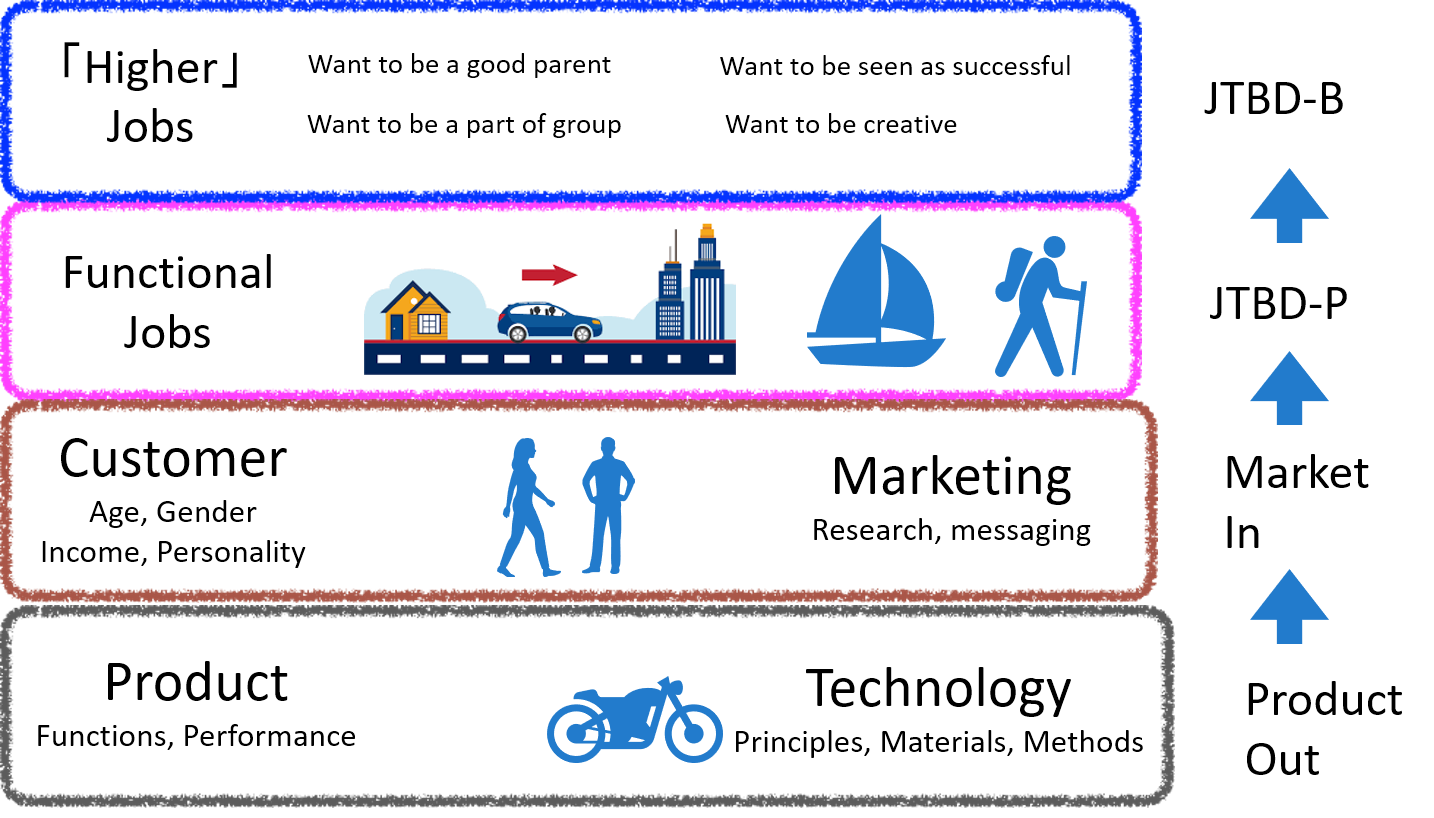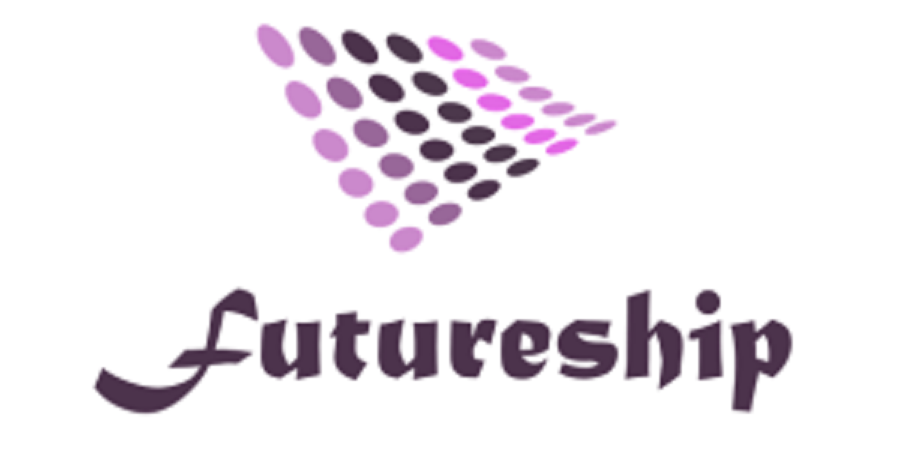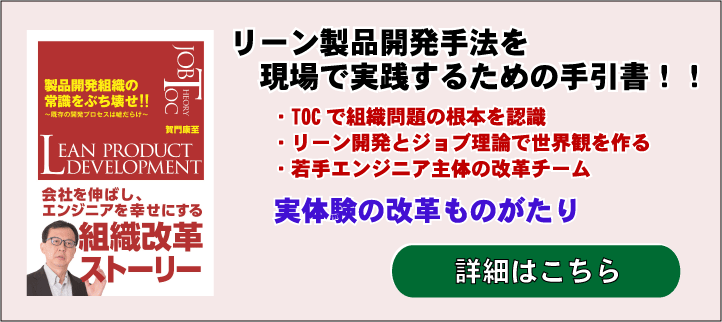

How do we get a hold of our customers’ latent needs in order to come up with a hit product?!
Existing businesses cannot be stable forever either. We want to develop products with new concepts, but we want to differentiate our products by finding latent needs that customers are unaware of, and we want to know how to specifically find latent needs.
Based on our experience in supporting new business launches and organizational reforms for new product development, we will share our effective methods for capturing latent needs and bringing about innovation through our unique development method that combines elements of marketing theory with the Toyota method of lean product development.
In conclusion, the methods and tools we use to capture latent needs are as follows
- A framework utilizing job theory
- Applying design thinking to find bugs in behavior
- Ethnography
Individual methods will be described.
Contents of this article
3 Ways to Find Potential Customer Needs

Understanding customer value and exploring customers’ latent needs are the keys to innovation.
Many companies find that surveying or directly interviewing customers only elicits common sense requirements that everyone knows about.
If you listen too much to the direct voice of the customer, this leads to chasing needs that everyone knows about, which eventually leads to price competition.
If you can find out what your customers really want, which they are not even aware of, you can make a big difference to your competition.
In this session, we will explain how to find latent needs from the customer’s point of view, leaving the product axis behind.
A framework utilizing job theory

First of all, there is the Job Theory, which is known to be advocated by Professor Clayton Christensen of Harvard Business School.
It is positioned as a more advanced version of the Market-In approach, which tries to discover customers’ desires for change that they themselves are unaware of by looking for jobs to be done, rather than listening to the direct voice of the customer.
In the U.S., it is beginning to be used not only as a marketing tool, but also as a method for creating new businesses and for entrepreneurs.
Professor Christensen’s “Job Theory” has been published in Japan. The original title of the book is “Competing Against Luck,” which means that many innovations and business successes are the result of luck. The logic is that the essence of innovation cannot be captured by conventional marketing thinking, but can be clarified by JTBD.
The Job Theory and JTBD methods present a very interesting way of thinking in terms of creating customer value, but because they have not yet been fully incorporated into a framework, in order to actually utilize them, we must grasp the essence of the methods and put them into practice in our own situation.
On the other hand, before Christensen’s job theory, Anthony Ulwick presented a method of innovation by Jobs to be done (JTBD).
This one has the same concept in terms of capturing the customer’s job, but this one defines a framework that defines the customer’s job with the product with some awareness of the product. Ulwick’s method is also known as outcome-driven innovation.
Futureship divides JTBD into two levels and calls the one advocated by Ulwick, which is more similar to product development, JTBD-P (P of Product), and it is a method to create a hit product while exploring latent needs by considering the product function as a job, and the other is a more abstract method to create a job by considering the job as a The method is called JTBD-B (B for “Business”), which is a more situational approach, looking for the desire to evolve people’s lives while trying to derive new concepts and generate innovations.

We define the customer-driven approach in four stages as shown in the diagram above. The lowest stage is the product-out approach, which is technology-driven, and from there the market-in approach, which is the JTBD-P approach, which captures the functional job of the product, and the JTBD-B approach, which goes further and captures human needs, including emotional jobs.
We believe it is important to use these different methods depending on the situation.
The two job theories (JTBD-P and JTBD-B) are explained in detail in the following article.
Reference article: Use well two types of job theory
For JTBD-B, we have also developed our own framework and provide it to our clients.
For more details, please refer to the following.
Reference article: Teaches a framework for putting job theory into practice
The following is a very brief description of the job theory framework and its steps.
- View customer behavior as a story and define the connections between jobs.
- Map currently existing solutions for each job
- Map related business structures from the solution map
- Extract customer issues for each solution
- Develop ideas for new solutions to the identified issues
You can experience this framework at the “Marketing Thinking Skills Seminar”
Applying Design Thinking to Find Bugs in Behavior
Design thinking was originally born as a way of thinking about industrial design, or the visual design of things, but it is now widely used as a method and way of thinking that can be applied in various businesses and for customer-driven innovation.
Design Thinking is an approach to business and management that utilizes thinking methods in design creation, and can be described as “an innovation thinking method that finds essential needs that even customers are unaware of and transforms things.
The “Five Stages of Design Thinking” proposed by Professor Hasso Plattner is a well-known reference.
- Empathy
It is important to really put yourself in the customer’s shoes and see the view from there, rather than at the level of “customer perspective” or “empathy for the customer. - Definition
Instead of staying with superficial needs, we will define the underlying issues and why those needs are necessary. - Conceptualization
Brainstorm and otherwise express ideas for defined underlying issues. - Prototyping
The conceptualization is implemented. - Testing
The prototype is taken to the actual market and evaluated.
Considering these five stages, I think the key to success is to improve on levels 1 and 2.
As a way to become a customer, it is recommended to create a story of the customer’s behavior.
By recreating the story in your mind as if you were watching a video animation, you will be able to find the bugs in the behavior and extract the fundamental issues in 2.
You can also experience the aforementioned “Strengthening Marketing Thinking Skills Seminar” to learn more about finding bugs in design thinking.
Ethnography
Ethnography, originally used in cultural anthropology and folklore, is a research and survey methodology that uses observation and interviews to understand a subject.
Ethnography is often discussed together with design thinking, and an increasing number of manufacturing companies have recently adopted it to promote innovation.
The way ethnography is done in business is through
- On-site observation (observe as someone who is not there)
- Take the recordings back home for team discussion
- Idea generation
In broad terms, the procedure is as follows, but of course it requires tremendous cooperation from the client.
The observation itself also requires know-how, especially how to eliminate human cognitive bias.
Cognitive biases are those that
- Cognitive dissonance
Justify yourself - Anchoring effect
Pulled by criteria, focus on specific information - Confirmation Bias
Seeing only convenient facts, assumptions - Framing Effect
Impression changes depending on expression - halo effect
Only noticeable parts of the image are seen - Observer effect
Be aware that you are being watched
The following are points to keep in mind when conducting behavioral observations.
- Hypotheses are to be discarded, not hypotheses that are too strong.
- Be someone who is, but isn’t.
- Record “facts” only
- Not taking for granted what is right in front of you
- Do not think of solutions on the spot
- There is always a reason for customer behavior
- Don’t take your customer’s word for it
- Be aware that you will be filtered
- Be aware of the whole and its parts, do not focus on one point
Behavioral observation, as a complementary relationship to interviewing, confirms the insights gained from behavioral observation by interviewing the customer again.
The combination of ethnography and design thinking should be able to transform the organization into one that innovates.
Summary

We have described how to find latent needs using three methods: job theory, design thinking, and ethnography.
As you may have noticed, the methods in each are closely related to each other and also share a common essence.
The common essence is to view customer behavior as a story.
There is always a reason for the customer’s behavior, and there are also customer assumptions in the customer’s behavior.
We are accepting the status quo, but we are accepting something we inherently do not want to accept.
Humans are full of assumptions and have strong cognitive biases.
If we can capture the customer’s behavior through his/her cognitive bias without eliminating the cognitive bias, we can find what the customer really wants.
Job Theory captures customer behavior and desires as jobs, and by linking design thinking with stories and developing it into a bug-finding approach, and by conducting a thorough observation of behavior to find more bugs, we can increase the probability of innovation.


